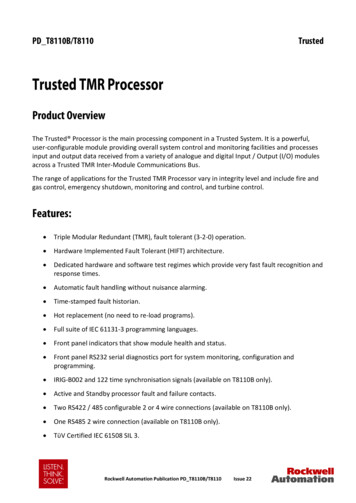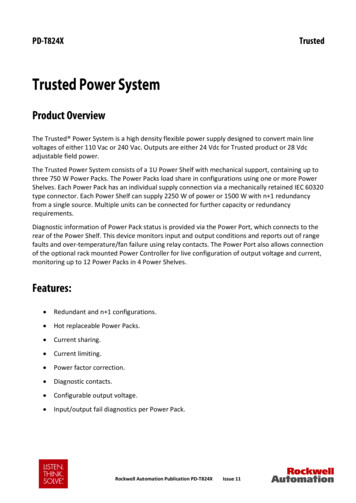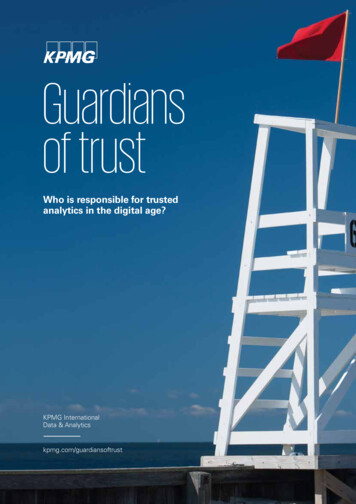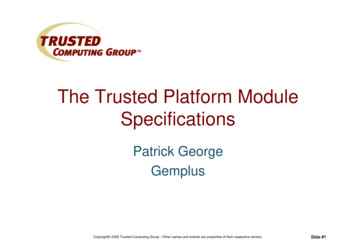
Transcription
The Trusted Platform ModuleSpecificationsPatrick GeorgeGemplusCopyright 2005 Trusted Computing Group - Other names and brands are properties of their respective owners.Slide #1
Overall Presentation Goals Introduce the Trusted Computing Group (TCG) Provide a medium/high level view of the TrustedPlatform Module (TPM)– Architecture– Functionality– Use cases Discuss the relationships between smart cards andTPM in Trusted Computing architecturesCopyright 2005 Trusted Computing Group - Other names and brands are properties of their respective owners.Slide #2
TCG MissionDevelop and promote open, vendorneutral, industry standard specificationsfor trusted computing building blocksand software interfaces across multipleplatformsCopyright 2005 Trusted Computing Group - Other names and brands are properties of their respective owners.Slide #3
TCG Structure TCG is incorporated as a not-for-profit corporation,with international membership– Open membership model Offers multiple membership levels: Promoters, Contributors,and Adopters– Board of Directors Promoters and member elected Contributors– Typical not-for-profit bylaws– Industry typical patent policy (Reasonable and NonDiscriminatory) for all published specifications– Working GroupsCopyright 2005 Trusted Computing Group - Other names and brands are properties of their respective owners.Slide #4
TCG OrganizationBoard of DirectorsJim Ward, IBM, President and Chairman, Geoffrey Strongin, AMD, Mark Schiller, HP, David Riss, Intel, Steve Heil,Microsoft, Tom Tahan, Sun, Nicholas Szeto, Sony, Bob Thibadeau, Seagate, Thomas Hardjono, VeriSignMarketing WorkgroupTechnical CommitteeAdvisory CouncilAdministrationBrian Berger, Wave SystemsGraeme Proudler, HPInvited ParticipantsVTM, Inc.PublicRelationsAnne Price,PR WorksEventsMarketingSupportTPM Work GroupConformance WGDavid Grawrock, IntelRandy Mummert, AtmelTSS Work GroupPC Client WGDavid Challener, LenovoMonty Wiseman, IntelMobile Phone WGInfrastructure WGJanne Uusilehto, NokiaThomas Hardjono, VeriSignNed Smith, IntelPeripherals WGStorage SystemsVTM, Inc.Colin Walters, ComodoPosition KeyGREEN Box:BLUE Box:RED Box:BLACK Box:Elected OfficersChairs Appointed by BoardChairs Nominated by WG,Appointed by BoardResources Contracted by TCGRobert Thibadeau,SeagateServer Specific WGLarry McMahan, HPMarty Nicholes, HPHard Copy WGBrian Volkoff, HPCopyright 2005 Trusted Computing Group - Other names and brands are properties of their respective owners.Slide #5
TCG Membership110 Total Members as of August 18, 20057 Promoter, 71 Contributor, 32 AdopterPromotersAMDHewlett-PackardIBMIntel CorporationMicrosoftSony CorporationSun Microsystems, Inc.ContributorsAgere SystemsAmerican Megatrends, Inc.ARMATI Technologies Inc.AtmelAuthenTec, Inc.AVAYABroadcom CorporationCerticom Corp.Citrix Systems, Inc.ComodoDell, Inc.Endforce, Inc.Ericsson Mobile Platforms ABExtreme NetworksFrance Telecom GroupFreescale SemiconductorFujitsu LimitedContributorsFujitsu Siemens ComputersFunk Software, Inc.GemplusGeneral Dynamics C4 SystemsGiesecke & DevrientHitachi, Ltd.InfineonInfoExpress, Inc.InterDigital CommunicationsiPassLenovo Holdings LimitedLexmark InternationalM-Systems Flash Disk PioneersMeetinghouse DataCommunicationsMirage NetworksMotorola Inc.National SemiconductornCipherNECNetwork AssociatesNevis Networks, USANokiaNTRU Cryptosystems, Inc.NVIDIAOSA Technologies, IncPhilipsPhoenixPointsec Mobile TechnologiesContributorsRenesas Technology Corp.Ricoh Company LTDRSA Security, Inc.SafeNet, Inc.Samsung Electronics Co.SCM Microsystems, Inc.Seagate TechnologySignaCert, Inc.Sinosun Technology Co., Ltd.SMSCSTMicroelectronicsSygate Technologies, Inc.SymantecSymbian LtdSynaptics Inc.Texas InstrumentsTrend MicroTriCipher, Inc.UPEK, Inc.Utimaco Safeware AGVeriSign, Inc.Vernier NetworksVodafone Group Services LTDWave SystemsWinbond ElectronicsCorporationZone Labs, Inc.AdoptersAdvanced Network Technology LabsApani NetworksApere, Inc.BigFix, Inc.Bradford NetworksCaymas SystemsCirondCPR Tools, Inc.Credant TechnologiesFiberlink CommunicationsFoundry Networks Inc.Foundstone, Inc.Industrial Technology Research InstituteInfosec CorporationLockdown NetworksMarvell Semiconductor, Inc.MCIPC Guardian TechnologiesSafendSana SecuritySenforce Technologies, IncSilicon Integrated Systems Corp.Silicon Storage Technology, Inc.Softex, Inc.StillSecureSwan Island Networks, Inc.Telemidic Co. Ltd.Toshiba CorporationULi Electronics Inc.UnisysWebsenseCopyright 2005 Trusted Computing Group - Other names and brands are properties of their respective owners.Slide #6
TCG Specifications Trusted Platform Module (TPM) Specification 1.2TCG Software Stack (TSS) Specification 1.1TCG PC Specific Implementation Specification 1.1Infrastructure Specifications– Reference Architecture for Interoperability– Trusted Network Connect (TNC) specifications Generic Server SpecificationCopyright 2005 Trusted Computing Group - Other names and brands are properties of their respective owners.Slide #7
Trusted Platform A platform is trusted if it always behavesin the expected manner for the intendedpurpose– Is the platform what it claims to be?– Has the platform been modified orcompromised?– How are the secrets stored by the platformprotected?– Does it embed a genuine TPM?Copyright 2005 Trusted Computing Group - Other names and brands are properties of their respective owners.Slide #8
Trusted Platform Module (TPM) A silicon chip thatperforms all TPM v1.xfunctions, including:– Store platform integritymeasurement– Generate and store aprivate key– Hash files using SHA-1– Create digital signatures– Anchor chain of trust forkeys, digital certificatesand other credentialsCopyright 2005 Trusted Computing Group - Other names and brands are properties of their respective owners.Slide #9
TPM Architecture Turnkey secure module– Internal CPU to implement all TPM commands– Internal math engine to accelerate computation ofasymmetric algorithm operations– Tamper resistance to prevent physical attacks that mightreveal TPM or user secrets (EAL3 min. required)– Communications channel to main processor (LPC typical) Non-volatile memory– Owner information (on/off, owner auth secret, configuration)– Platform attestation information Integrity metrics storage––––Multiple instances of Platform Configuration Registers (PCR)Can be extended (hash with new value) but not clearedKey usage can be connected to desired valuesPlatform can provide attestation of current valuesCopyright 2005 Trusted Computing Group - Other names and brands are properties of their respective owners.Slide #10
TPM Architecture (cont’d) Asymmetric cryptography engine– RSA support mandatory (512 through 2048 bit key length),other algorithms optional. On board key generation.– On board key cache stores frequently used keys, arbitrarynumber stored on disk. Off chip keys are protected using keythat never leaves TPM.– Keys can be migrated from one TPM to another – if both theTPM owner and the key owner authorize the operation and ifthe key has been appropriately tagged at creation High quality random number generator– Used to prevent replay attacks, generate random keys SHA-1 hash computation engine– Multiple uses: integrity, authorization, PCR extension, etc.Copyright 2005 Trusted Computing Group - Other names and brands are properties of their respective owners.Slide #11
TPM Block testationConfigurationIdentityRegister (PCR)Key AEngineGenerationEngineOpt-InExecEngineTrusted Platform Module (TPM)Tamper-Protected PackagingCopyright 2005 Trusted Computing Group - Other names and brands are properties of their respective owners.Slide #12
TPM 1.1b Functions Asymmetric key functions– On-chip key pair generation– Digital signature– Encryption/decryption of keys Secure storage and secure reporting of platformconfiguration information– Enable verifiable attestation of the platform configuration– Including creation of Attestation Identity Keys (AIK) An Endorsement Key (EK)– Anonymously establish that AIK were generated in a TPM Initialization and management functions––––Allow platform owner to turn functionality on or offReset the chipTake ownership while protecting the user privacyOpt-inCopyright 2005 Trusted Computing Group - Other names and brands are properties of their respective owners.Slide #13
Integrity MeasuresPlatformTPMPCR1234567890ABCD Reports1234567890ABCD etc ReportsMeasuresMeasuresCRTMCopyright 2005 Trusted Computing Group - Other names and brands are properties of their respective owners.Slide #14
Platform IdentitiesPlatformTPMAliasAIKPrivacy CAEKCopyright 2005 Trusted Computing Group - Other names and brands are properties of their respective owners.Slide #15
Platform AttestationPlatformTPMPCRAIK1234567890ABCD 1234567890ABCD Verify1234567890ABCD 1234567890ABCD ChallengerCopyright 2005 Trusted Computing Group - Other names and brands are properties of their respective owners.Slide #16
Sealed StoragePlatformTPMSRKPCR1234567890ABCD 1234567890ABCD Condition usageSeal1234567890ABCD 1234567890ABCD Copyright 2005 Trusted Computing Group - Other names and brands are properties of their respective owners.Slide #17
TPM 1.2 New Functions TPM 1.1b backward compatibility Direct Anonymous Attestation– Protocol to remotely prove that a key is held in somehardware– Combine device strong authentication with privacy protection– Complement attestation functions in 1.1b Locality– Allows the TPM to differentiate between commands fromdifferent LOCAL sources Normal applicationTrusted applicationTrusted OSTrusted chip set– Enables more than one simultaneous root of trust to existper platformCopyright 2005 Trusted Computing Group - Other names and brands are properties of their respective owners.Slide #18
TPM 1.2 New Functions (cont’d) Delegation– Allow TPM owner to delegate other entities to use specificowner-authorized commands without allowing access toother commands in the TPM Non-volatile storage– Allow system software or firmware to store information onthe TPM Others– Optimized transport protection– Monotonic counters– Tick counterCopyright 2005 Trusted Computing Group - Other names and brands are properties of their respective owners.Slide #19
TPM Use Cases Secure Boot– Different from authenticated boot– Prevent the platform from booting if adifference exists between the actual bootprocess and the expected boot process– Can be achieved by using non volatilememory (or Data Integrity Registers inTPM1.1b) to hold the critical integritymeasuresCopyright 2005 Trusted Computing Group - Other names and brands are properties of their respective owners.Slide #20
TPM Use Cases (cont’d) End-point integrity (TNC)– Introduce the notion of “health” of a clientcomputer wishing to gain enterprisenetwork access AV version, OS patches, drivers– Authentication server evaluates healthlevel of the client– Healthy client allowed network access,unhealthy clients denied or placed intoremedial networkCopyright 2005 Trusted Computing Group - Other names and brands are properties of their respective owners.Slide #21
TCG Software Stack TSS enables applicationdevelopment andinteroperability– Supply one entry point forapplications to the TPMfunctionality– Provides synchronizedaccess to the TPM– Hide building commandstreams with appropriatebyte ordering and alignmentfrom applications– Manage TPM resources Several UOpen Source (TrouSerS)ApplicationsCryptographic APICSPTSS SPITSS Service ServicesTSS CSITSS Core ServicesTPM DDLITPM Device Driver LibraryTPM Device DriverTPMCopyright 2005 Trusted Computing Group - Other names and brands are properties of their respective owners.Slide #22
Common Misconceptions The TPM does not measure, monitor or control anything– Software measurements are made by the PC and sent to the TPM– The TPM has no way of knowing what was measured– The TPM is unable to reset the PC or prevent access to memory The platform owner controls the TPM– The owner must opt-in using initialization and managementfunctions– The owner can turn the TPM on and off– The owner and users control use of all keys DRM is not a goal of TCG specifications– All technical aspects of DRM are not inherent in the TPM TPMs can work with any operating systems or applicationsoftware– The spec is open and the API is defined, no TCG secrets.– All types of software can make use of the TPMCopyright 2005 Trusted Computing Group - Other names and brands are properties of their respective owners.Slide #23
Implementation Status Trusted Platform Modules (TPM) based on 1.1b and1.2 specifications available from multiple vendors– Atmel, Broadcom, Infineon, National Semiconductor Compliant PC platforms shipping now– IBM ThinkPad notebooks, NetVista desktops and eServerxSeries 366 servers– HP D530 Desktops and many notebooks– Dell Latitude D410, D610 and D810– Intel D865GRH motherboard– TPM1.2-based are announced Application support by multiple ISV’s– Existing familiar applications are using TCG/TPM throughstandard cryptographic APIs like MS-CAPI and PKCS#11– RSA* Secure ID, Checkpoint VPN, VeriSign PTACopyright 2005 Trusted Computing Group - Other names and brands are properties of their respective owners.Slide #24
TPM and Smart CardsFrom competition to cooperationCopyright 2005 Trusted Computing Group - Other names and brands are properties of their respective owners.Slide #25
TCG PositionHow do TPMs compare with smart cards?The TPM is a fixed token that can be used toenhance user authentication, data,communications, and/or platform security.A smart card is a portable token traditionallyused to provide more secure authentication fora specific user across multiple systems.Both technologies can have a role in design ofmore secure computing environments.Copyright 2005 Trusted Computing Group - Other names and brands are properties of their respective owners.Slide #26
TPM vs. Smart Card Similar hardware capabilities– Micro controllers– RAM, ROM, Flash Common cryptographic services– Asymmetric cryptography– Hash functions Comparable tamper resistance– EAL3 to EAL5 Specialized close firmware vs. open multi-purposeplatform– Integrity measures reporting– Unique Endorsement Key– Locality Fixed vs. removableCopyright 2005 Trusted Computing Group - Other names and brands are properties of their respective owners.Slide #27
Other Opinion“It can be seen that smart card-based userauthentication and TPM-based machineauthentication are complementary, rather thancompeting, technologies.” (Dell)User/Machine Authentication ScenarioSmart CardTPMUser ID for VPN accessUser ID for domain logonUser ID for building accessUser ID for secured emailPlatform ID for VPN accessPlatform ID for domain accessPlatform ID for attestationCopyright 2005 Trusted Computing Group - Other names and brands are properties of their respective owners.Slide #28
A First Step Toward Cooperation The TPM user must be authorized before using TPMprotected resources User authentication is based on the proof of knowledgea a secret shared between the user and the TPM This methods raises security concerns A smart card can be used to perform userauthentication without exposition the AuthorizationDataUser****Enter PINProof knowledgePlatformSend TPM commandTPMTPM responseCopyright 2005 Trusted Computing Group - Other names and brands are properties of their respective owners.Slide #29
Other Areas of Cooperation Does one security device fit all?– Same device for platform and user secrets? Separate credentials––––User credential portabilityUser administration simplificationProtection level adequacyUser privacy Leverage from corporate deployments– Logical access to computers– Physical access control badges too Toward a smartcard-and-TPM cooperativemodelCopyright 2005 Trusted Computing Group - Other names and brands are properties of their respective owners.Slide #30
TCG Information For information on TCG membership andprogramsTCG Administration5440 SW Westgate Dr., Suite 217Portland, OR 9722PH: 503.291.2562 FX: stedcomputinggroup.org For technical information & nggroup.orgCopyright 2005 Trusted Computing Group - Other names and brands are properties of their respective owners.Slide #31
QuestionsCopyright 2005 Trusted Computing Group - Other names and brands are properties of their respective owners.Slide #32
Credant Technologies Fiberlink Communications Foundry Networks Inc. Foundstone, Inc. Industrial Technology Research Institute Infosec Corporation Lockdown Networks Marvell Semiconductor, Inc. MCI PC Guardian Technologies Safend Sana Security Senforce Technologies, Inc Silicon Integrated Systems Corp. Silicon Storage Technology, Inc. Softex, Inc.


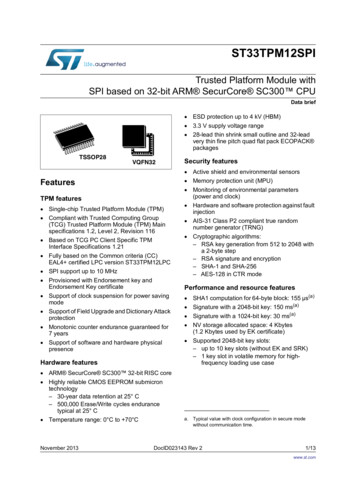
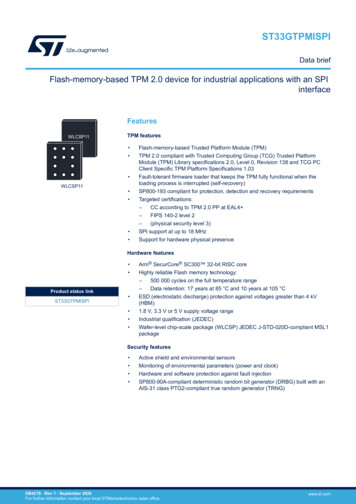
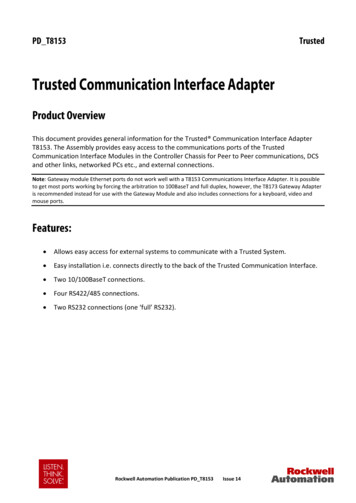
![[MS-TPMVSC]: Trusted Platform Module (TPM) Virtual Smart Card .](/img/62/5bms-tpmvsc-5d-210407.jpg)

